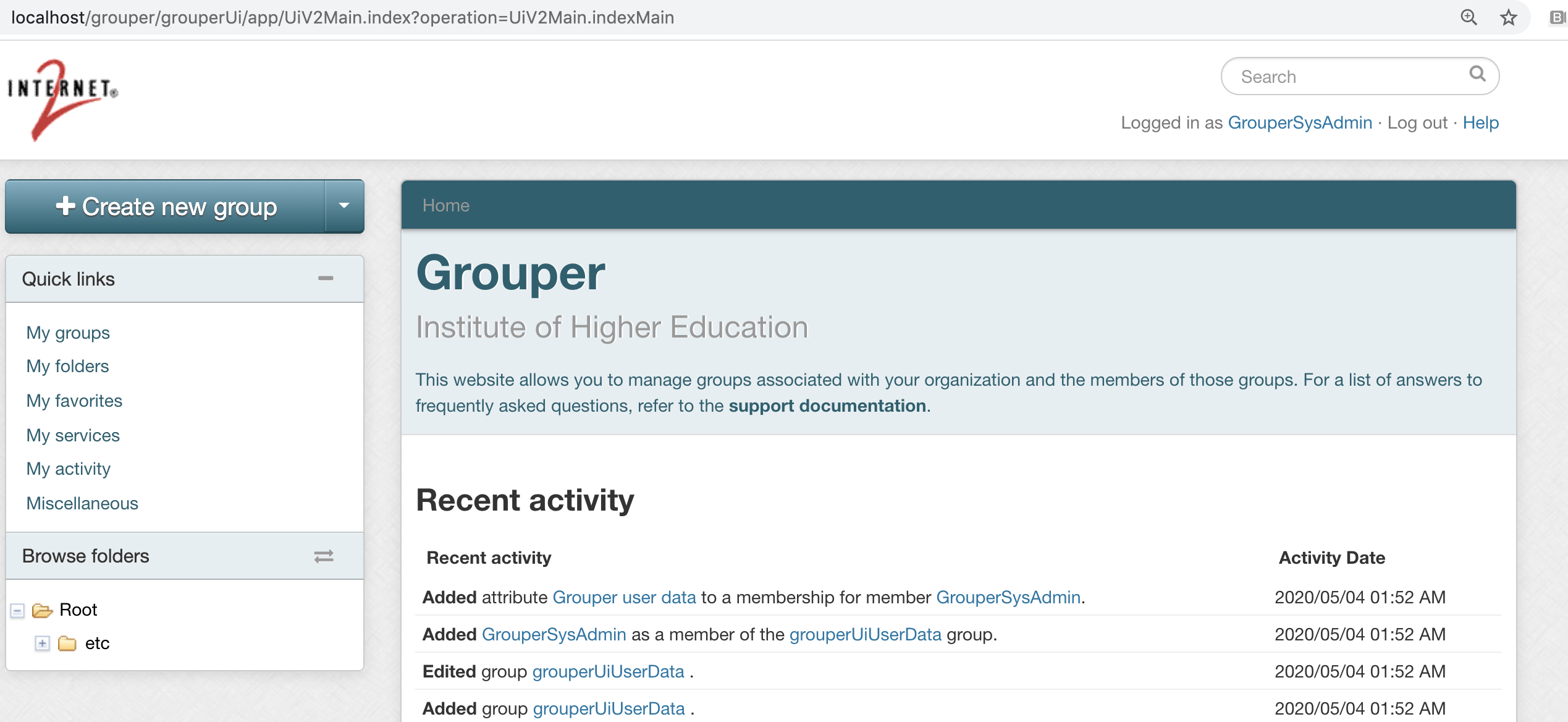| Include Page | ||||
|---|---|---|---|---|
|
This page is OUTDATED. Use this quickstart instead.
Description
The For the latest quick start go here
This quickstart is the easiest way to start Grouper. You need a computer with Docker (or another container technology that runs Docker format containers). Run the container and it will start an embedded HSQLDB database (that does not persist across restarts unless you mount the database directory outside of your container... as outlined below).
...
| Gliffy Diagram | ||||||
|---|---|---|---|---|---|---|
|
Get a server
Here is an example with AWS, basically for this example you need a Unix-based server (or Mac). Install Docker as well
Install the container
- See which version of Grouper to run (at least v2.5.27)
Issue a run command to run the quick start.
Note, for the morph string encrypt and quick start pass, just make up a 16 char alphanumeric string or generate from a password manager.
Note, this is not good security. It is for quick starts only. As you evolve to maturity level 0, you can set a different password encrypted in the database which will not be in a script file or in an env variable, and you can further evolve to Shibboleth or another authentication system.
Note: the first port is the port for apache SSL, change that to whatever you need on your host (i.e. one that is not in use and one that you can get to through the network)
Code Block $ docker run --detach --restart always --name grouper-qs \ --publish 443:443 -e GROUPER_MORPHSTRING_ENCRYPT_KEY=******** \ -e GROUPERSYSTEM_QUICKSTART_PASS=******** i2incommon/grouper:2.5.XX quickstarte.g.
Code Block docker run --detach --restart always --name grouper-qs \ --publish 443:443 -e GROUPER_MORPHSTRING_ENCRYPT_KEY=abcdefg12345dontUseThis \ -e GROUPERSYSTEM_QUICKSTART_PASS=thisPassIsCopyrightedDontUse i2incommon/grouper:2.5.2737 quickstart
Log in to UI (note, the first log in can take a minute as HSQLDB database is started and initted.)
Note: change "localhost" to your server IP address or domain name, and add the port if not 443. e.g. https://server.whatever.edu:1234/grouper/
Code Block Go to: https://localhost/grouper/ Log in with username : GrouperSystem Password is the password you specified in the GrouperSystem QuickStart pass
Try a web service call
Code Block Get the client out of the container (or download from maven) $ docker cp grouper-qs:/opt/grouper/grouperWebapp/WEB-INF/lib/grouperClient-2.5.XX.jar . Now you should have a grouper client jar in your directory Make a config file in the same directory $ vi grouper.client.properties # note add the port after localhost if not using 443 grouperClient.webService.url = https://localhost/grouper-ws/servicesRest grouperClient.webService.login = GrouperSystem grouperClient.webService.password = ****** is the password you specified in the GrouperSystem QuickStart pass # turn off SSL until a real SSL certificate is installed # NOTE, THIS IS NOT GOOD SECURITY AND IS FOR THE QUICK START ONLY! grouperClient.https.customSocketFactory = edu.internet2.middleware.grouperClient.ssl.EasySslSocketFactory $ java -jar grouperClient-2.5.XX.jar --operation=getSubjectsWs --subjectIds=GrouperSystem Index: 0: success: T, code: SUCCESS, subject: GrouperSystem $
Expand title Full web service call Code Block grouperContainer $ java -jar grouperClient-2.5.0-SNAPSHOT.jar --operation=getSubjectsWs --subjectIds=GrouperSystem --debug=true Reading resource: grouper.client.properties, from: /Users/mchyzer/grouper/docker/grouperContainer/grouper.client.properties WebService: connecting as user: 'GrouperSystem' WebService: connecting to URL: 'https://localhost/grouper-ws/servicesRest/2.5.0-SNAPSHOT/subjects' ################ REQUEST START (indented) ############### POST /grouper-ws/servicesRest/2.5.0-SNAPSHOT/subjects HTTP/1.1 Connection: close Authorization: Basic xxxxxxxxxxxxxxxx User-Agent: Jakarta Commons-HttpClient/3.1 Host: localhost:-1 Content-Length: 161 Content-Type: text/xml; charset=UTF-8 <WsRestGetSubjectsRequest> <wsSubjectLookups> <WsSubjectLookup> <subjectId>GrouperSystem</subjectId> </WsSubjectLookup> </wsSubjectLookups> </WsRestGetSubjectsRequest> ################ REQUEST END ############### ################ RESPONSE START (indented) ############### HTTP/1.1 200 OK Date: Mon, 04 May 2020 02:38:16 GMT Server: Apache/2.4.6 (CentOS) OpenSSL/1.0.2k-fips Strict-Transport-Security: max-age=15768000 Set-Cookie: JSESSIONID=xxxxxxxxxxxx; HttpOnly X-Grouper-resultCode: SUCCESS X-Grouper-success: T X-Grouper-resultCode2: NONE Content-Type: application/xml;charset=UTF-8 Connection: close Transfer-Encoding: chunked <WsGetSubjectsResults> <wsSubjects> <WsSubject> <resultCode>SUCCESS</resultCode> <success>T</success> <id>GrouperSystem</id> <name>GrouperSysAdmin</name> <sourceId>g:isa</sourceId> </WsSubject> </wsSubjects> <resultMetadata> <resultCode>SUCCESS</resultCode> <resultMessage>Queried 1 subjects</resultMessage> <success>T</success> </resultMetadata> <responseMetadata> <resultWarnings></resultWarnings> <millis>19</millis> <serverVersion>2.5.0-SNAPSHOT</serverVersion> </responseMetadata> </WsGetSubjectsResults> ################ RESPONSE END ############### Output template: Index: ${index}: success: ${success}, code: ${wsSubject.resultCode}, subject: ${wsSubject.id}, available variables: wsGetSubjectsResults, grouperClientUtils, index, wsSubject, wsGroup, success Index: 0: success: T, code: SUCCESS, subject: GrouperSystem Elapsed time: 612ms grouperContainer $
Advanced
Verify the digest of the image. This is a best practice when using Grouper images
Pull the image
Code Block bin $ docker pull i2incommon/grouper:2.5.XX
Make sure the digest is correct (from release notes page)
Code Block [root@ip-172-30-3-152 ~]# docker image inspect i2incommon/grouper:2.5.XX | grep i2incommon/grouper@sha256 "i2incommon/grouper@sha256:b675bb410bf873xxxxxxxxxxxxxx5e58a3a42a8048381a33b79fd19"
Make the start command in a script so you have it to run it later consistently
Code Block grouperContainer $ vi grouperQsDockerRun.sh #!/bin/bash (or whatever shell) # this is the run command from above that you diddockerdid docker run --detach --restart always --name grouper-qs \ --publish 443:443 -e GROUPER_MORPHSTRING_ENCRYPT_KEY=******** \ -e GROUPERSYSTEM_QUICKSTART_PASS=******** i2incommon/grouper:2.5.XX quickstart grouperContainer $ chmod +x grouperQsDockerRun.sh # remove the old container if you want to run it again, or stop, or whatevergrouperContainer $ docker rm -f grouper-qsgrouperContainer $ ./grouperQsDockerRun.sh (Optional) Check logs: grouperContainer $ docker logs grouper-qs (Optional) Shell in: grouperContainer $ docker exec -it grouper-qs /bin/bash
(Optional) Mount your database files outside of Docker to persist your changes across container restarts. Note, this is still not a robust database, it is only for non production use.
Code Block $ mkdir hsqldb Change your start command to include a mount of this directory grouperContainer $ vi grouperQsDockerRun.sh Add this mount in your command --mount type=bind,src=/path/to/hsqldb,dst=/opt/hsqldb You might need to open up permissions on that directory: $ chmod 777 hsqldb Delete the current container $ docker rm -f grouper-qs Start it again $ ./grouperQsDockerRun.sh You will see database files in that dir on your host grouperContainer $ ls -latr hsqldb/ total 6192 drwxr-xr-x 22 mchyzer staff 704 May 3 22:58 .. drwxr-xr-x 2 mchyzer staff 64 May 3 22:58 grouperHSQL.tmp -rw-r--r-- 1 mchyzer staff 1536 May 3 22:58 grouperHSQL.script -rw-r--r-- 1 mchyzer staff 85 May 3 22:58 grouperHSQL.properties drwxrwxrwx 7 mchyzer staff 224 May 3 22:58 . -rw-r--r-- 1 mchyzer staff 16 May 3 23:00 grouperHSQL.lck -rw-r--r-- 1 mchyzer staff 2854600 May 3 23:00 grouperHSQL.log
- Evolve to maturity level 0
